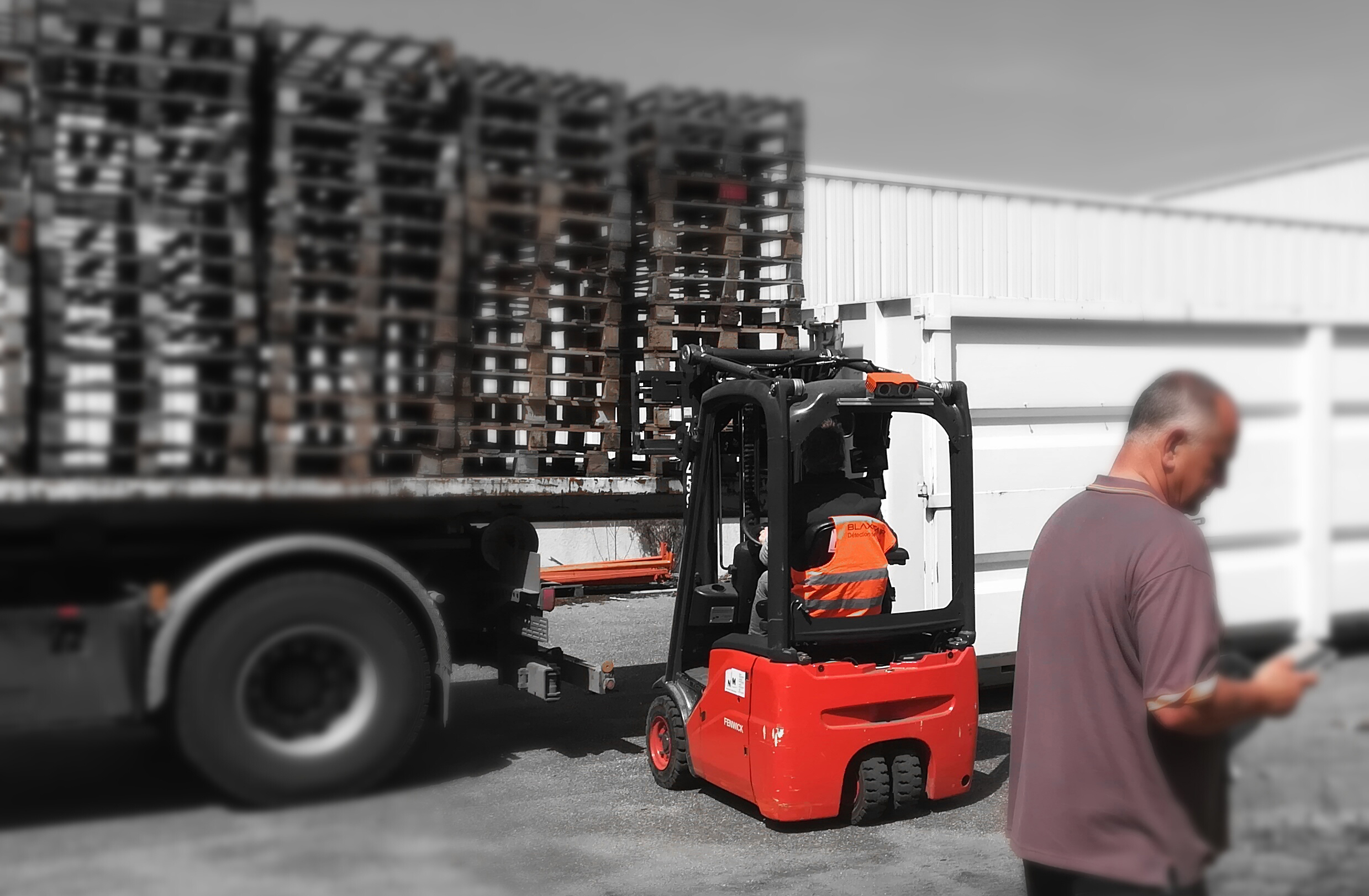
Did you know?
– 1 in 10 forklifts will be in an Accident this year!
– It is a matter of “WHEN” not “IF”
– If the fleet is 10 or more – an ACCIDENT will happen THIS YEAR!
See below how to Prevent Warehouse Traffic Accidents – SAVE LIVES & AVOID LOSS with our variety of effective TRAFFIC SAFETY HIGH-TECH PRODUCTS.
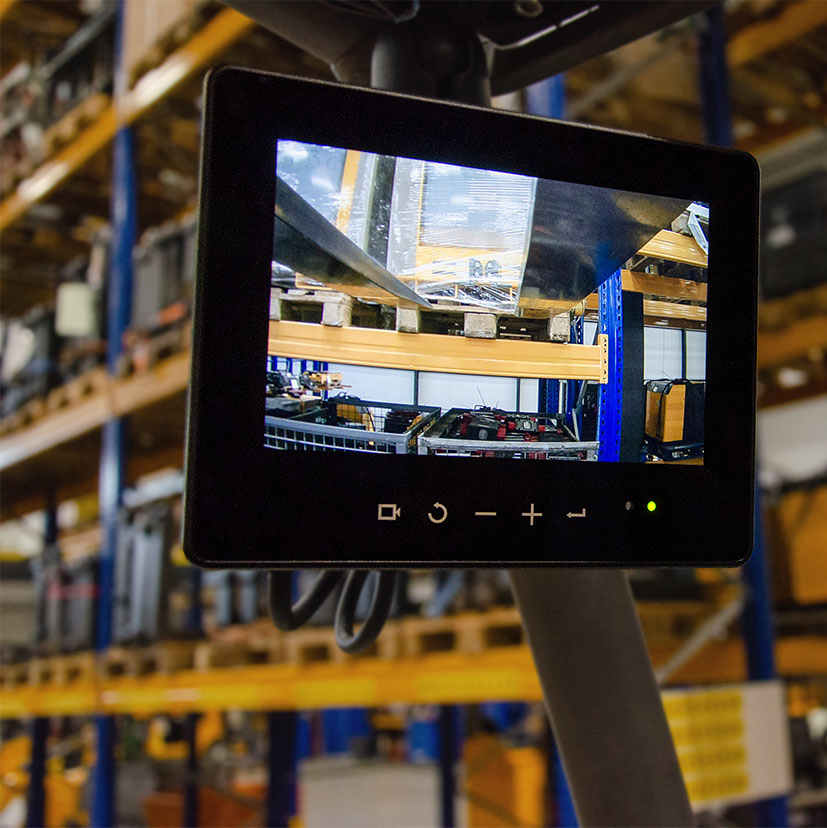
• What is a Fork Camera system: A device for the operator to see the forks when going into a pallet at height.
• How do Cameras Work: Wired or wireless camera mounted to the forks or fork carriage, linked to a HD monitor that is installed in the operator compartment.
• What types of equipment use these: Any forklift. Can be I.C. or Electric Power.
• Will the camera interfere with any warehouse tech or other machine functions: No, the camera system is a simple setup of a monitor, camera, HD cable and 12V inverter for specific electric forklifts.
• How is the camera powered: By batteries or by a connection to the unit’s battery.
• Who should install this: It is recommended that the authorized dealer for the systems provide installation options for you. Installation can normally be done onsite at a customer facility, or at the authorized dealership.
• IT Involvement: None.
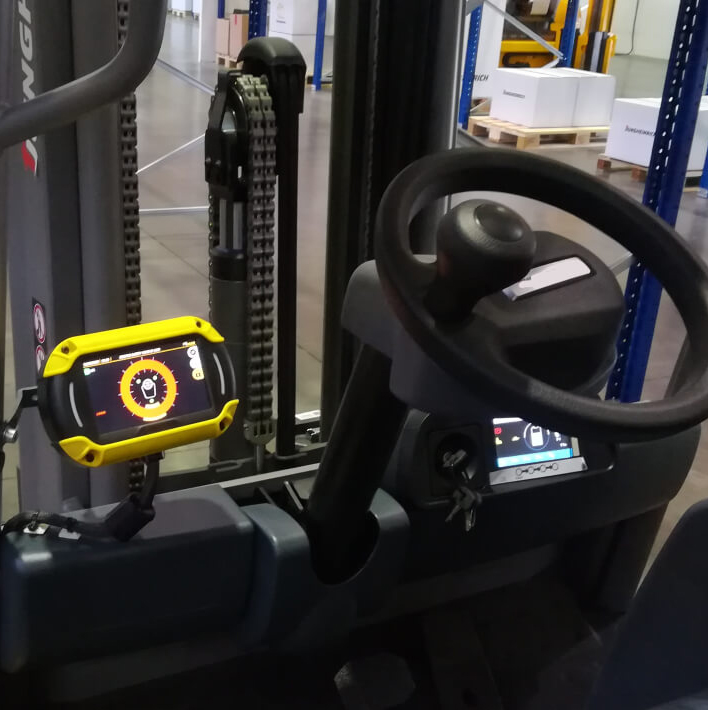
• What is it: Pedestrian Detection Installed on Equipment
• How does it work: Ultra-Wide Band Technology for 360 Deg. Coverage
• How does it detect: By the operator and pedestrian wearing a “TAG”
• What does the “TAG” do: Vibrates, and lights up when near a machine.
• How does the driver know: A display monitor in the cab shows the position of the person in a colored band on a side of the cab
• What happens when detected: if the pedestrian is within a range of coverage – the machine will automatically slow down to 50% of the speed its going.
• Is the Zone adjustable: Yes it is adjustable for distance in 2 ways up to 80 feet in any direction.
• Impacts recorded: Yes, and near miss situations are also recorded by machine, by driver, by date, or by time
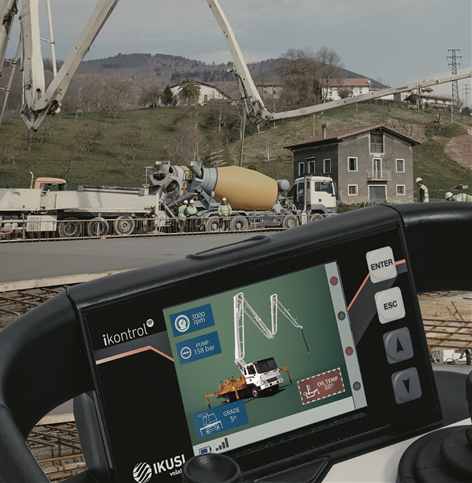
• What is a Fork Camera system: A device for the operator to see the forks when going into a pallet at height.
• How do Cameras Work: Wired or wireless camera mounted to the forks or fork carriage, linked to a HD monitor that is installed in the operator compartment.
• Will the camera interfere with any warehouse tech or other machine functions: No, the camera system is a simple setup of a monitor, camera, HD cable and 12V inverter for specific electric forklifts.
• How is the camera powered: The camera system is powered either by batteries or by a direct wire to the machines battery supply.
• Who should install this: It is recommended that the authorized dealer for the systems provide installation options for you. Installation can normally be done onsite at a customer facility, or at the authorized dealership.
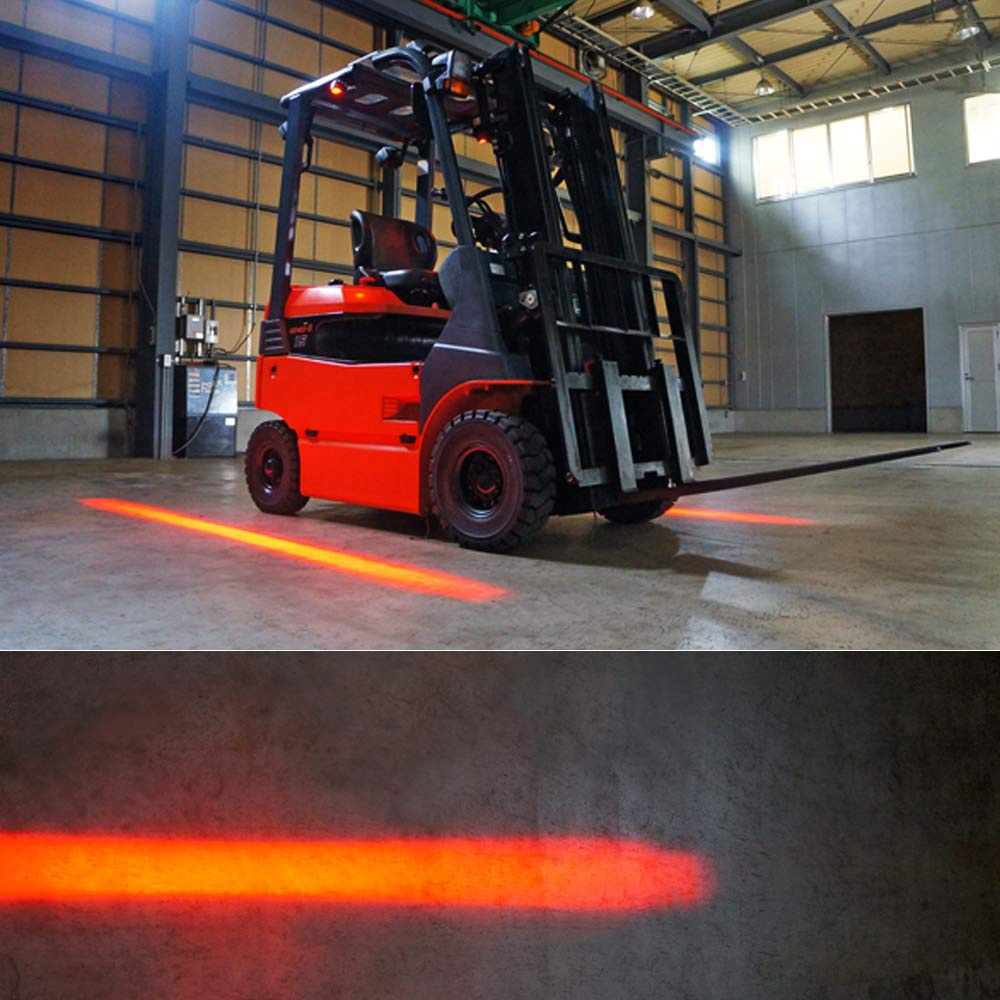
• What is a laser projector: High powered laser projector that shoots an adjustable red or green line on a surface.
• How Does it work: Simple 110/120V standard outlet plug in wall system. Can be mounted to any surface with included mounting plate hardware. 90 degree projection.
• How bright is the line: Laser lines will not compete with direct sunlight, but for indoor use the laser line is bright and solid from end to end never needing to be re applied and never covered by any material.
• How long do they last: Laser systems last on average about 14,000 hours of use or about 7 years total based on 2000 hours a year use.
• Where can they be used: Indoor and outdoor use as they are IP65 rated for high resistance to water and fine particulate. Temp rated from -4 to 104 Deg. Fahrenheit
• Is the laser dangerous to look at: No, the laser is as powerful as a PC mouse laser.
Here are eight accident statistics that should cause you to exercise extreme caution when operating a forklift:
1. Forklifts account for around 85 deaths every year – a 28% Increase since 2011
2. Forklift accidents that result in serious injury total $34,900 annually.
3. Non-serious injuries related to forklift accidents reach $61,800 each year.
4. A forklift overturning is the most common incident, accounting for 24% of all forklift accidents.
5. If companies implemented more stringent training policies, the Occupational Safety & Health Administration (OSHA) estimates that about 70% of forklift accidents in the US could be prevented.
6. On average 100 people are seriously injured in a forklift accident every day and 1 person is killed in a forklift accident every 4 days in the United States alone.
7. 36% of forklift-related deaths are pedestrians
8. Approximately 11% of forklifts in the United States will be involved in an accident each year. Meaning if your facility has 10 or more – something is going to happen this year.
Approximately one in ten forklifts are involved in accidents every year and cause almost 100,000 injuries annually. Besides the number of hurt citizens, forklift accidents cause many other catastrophes with one being the devastating costs.
When safety training has the power to help companies save thousands of dollars each year and prevent accidents, it’s an investment that pays for itself multiple times over. However, many companies skip this essential training and put their entire workplace in danger, risking the following hidden costs.
Equipment Damage Repairs and Replacements
A few years ago, a maintenance worker in Massachusetts was tending to commercial flower beds, digging up the flower beds along the streets, when his forklift randomly collapsed and fell through the sidewalk to a delivery chute underneath. After the investigation, it was found that the worker did not know that the city’s sidewalks are built on top of loose, decades-old grating. The accident did not kill the worker but it most certainly caused substantial damages to the forklift and to the sidewalk area the employee was working on.
It’s estimated that a forklift out of commission for repairs costs thousands of dollars every day in lost profit. Forklift damage contributes greatly to the amount of unnecessary costs to a company. It’s estimated that forklift damage can add as much as 5% to the cost of a standard truck lease. When considering an entire fleet of powered trucks, the costs add up to thousands of dollars of unnecessary, unplanned costs each year.
Workers’ Compensation
It is the employer’s responsibility to cover any medical expenses for a worker injured in a work-related accident. The cost of forklift accidents involving injured workers can cost as high as $38,000 in direct costs per injured worker and $150,000 in indirect costs.
Loss of Production = Loss of Profits
According to the CDC, loss of productivity due to absent worker’s costs employers approximately $225.8 billion each year. This is about $1,685 per employee. Accidents involving forklifts may not only involve loss of productivity from an injured worker, but also medical expense coverage, equipment damage, and a forklift out of active duty. When calculating the cost of forklift accidents, employers also need to take into account the management time spent looking into the injured worker case, investigating the accident, and supervising the tasks needed to get the go-ahead to resume work.
Fines and Legal Costs
OSHA requires that employers provide a hazard-free work environment and safety training to employees. As a result, if they find out a workplace was operating under unsafe practices and with untrained workers following an accident, fines will be involved.For non-serious violations, fines start at $12,675 per violation.The penalty for willful or repeated violations is $126,749 per violation. The cost of forklift accidents extends well beyond the price of equipment repairs and structural damage; it may cost an employer their business.
Loss of Staff
A lack of safety in the workplace often leads to reduced morale and increased stress among employees. When keeping workers safe is a low priority, profits and worker pay is often negatively impacted. And when fear is brought into the picture following workplace accidents, a company may find itself lacking its best employees who left seeking greener pastures. The average cost of replacing personnel equals to about $30,000. For smaller organizations especially, the loss of key personnel may make it impossible to meet contract deadlines. The failure to complete projects can end a business, or tarnish a company’s reputation and lead to loss of new or repeat business.
The Serious Consequences of Forklift Accidents
Injured workers, forklift damages, and costly fines are serious consequences of forklift accidents. However, fatalities caused by forklift accidents are the very real and very serious consequences that can happen. It is estimated that about 100 forklift deaths happen every year on worksites, and the majority of them are preventable. Not only are employers left with the task of paying for any incurred medical expenses and compensation costs, but families are left without their loved ones. Proper training and certification is quite possibly the most important way for workers and employers to reduce the number of fatalities on worksites and to protect themselves from these severe consequences.
Why Are Forklifts So Dangerous?
There are a number of reasons why forklifts can be such a workplace hazard.
• They can weigh up to 9,000 pounds, which is three times heavier than many cars
• They can travel up to 18 mph
• Unlike a car, forklifts only have brakes in the front, making them harder to stop
• Forklifts are heavier in the rear to compensate for the heavy loads being carried in the front. This uneven weight distribution can make a forklift difficult to handle.
• A forklift is turned by the rear wheels, causing the rear end to swing outward. This increases the chance of tipping over during tight turns.
• Loads are carried in the front of a forklift, which can obstruct the view of the driver
• Forklifts are often used to raise hefty loads to considerable heights, a combination that is always dangerous
Product Details:
BLAXTAIR – ENHANCED SAFETY TECHNOLOGY
• The Blaxtair pedestrian detection system is revolutionizing industrial and commercial workplaces, making a huge difference in improving workplace safety. With several beneficial features, the system can not only improve safety but increases efficiency and productivity.
WHAT IS BLAXTAIR?
• Blaxtair is a pedestrian detection and anti-collision camera for forklifts that uses artificial intelligence to differentiate between objects and people so that operators are only alerted in a near-miss situation. The focus of the Blaxtair system is to reduce the number of alarms that operators hear so that they do not become desensitized to the alert, which can be the case for other proximity technologies such as radar or RFID-based systems.
BLAXTAIR V.S. RFID SYSTEMS
• Radio Frequency systems require employees to wear tagged equipment (vests, hard hats, etc.) for them to be detected. Not only is this difficult to manage with many employees, but it can also lead to useless alarms for people being in an area close to a forklift that is not deemed a dangerous situation.
BLAXTAIR VS RADAR SYSTEMS:
• Radar systems will give off alarms for anything picked up in the protected zone. This can be useful in wide-open spaces with minimal coactivity between PIV’s and people but can easily lead to over alarming in a more crowded facility.
• Blaxtair allows for efficient work within the industrial site by detecting any obstacles that may come across its path. The machine can recognize if the obstacle is a pedestrian or not by analyzing its shape. Should there be any imminent risk, the driver of the vehicle will be alerted, allowing prevention of a potentially fatal collision. The benefit of Blaxtair is that it does not affect productivity, by only warning the driver when there is a serious threat of harm or danger.
WHY IS PEDESTRIAN DETECTION IMPORTANT?
• Most people operating traditional obstacle detection systems know that they can hinder rather than help operations. BLAXTAIR differs from this as it will raise an alarm only if there is a pedestrian in danger of being struck by the vehicle. BLAXTAIR ensures total pedestrian safety without unnecessary alarms that may distract the operator, allowing for a productive, safe workplace.
Product Details:
Orlaco – HD Equipment Camera System
Orlaco produces a line of vision systems for fork-lifts and forklift trucks. From up high to down low; from the position of the forks, to the surroundings; orlaco cameras give the drivers a reliable crystal clear image. From up high to down low; the position of the forks, the load, and the surroundings. A better view increases the driver’s awareness, improves safety and reduces risks. An ideal solution for a more productive day on the job.
• What is a Fork Camera system: A device for the operator to see the forks when going into a pallet at height.
• How do Cameras Work: Wired or wireless camera mounted to the forks or fork carriage, linked to a HD monitor that is installed in the operator compartment.
• WHAT TYPES OF EQUIPMENT USE THESE: Any forklift that requires a high lift height to move a pallet where visibility is diminished. Can be I.C. or Electric Power.
• Will the camera interfere with any warehouse tech or other machine functions: No, the camera system is a simple setup of a monitor, camera, HD cable and 12V inverter for specific electric forklifts.
• How is the camera powered: The camera system is powered either by batteries or by a direct wire to the machines battery supply.
• Who should install this: It is recommended that the authorized dealer for the systems provide installation options for you. Installation can normally be done onsite at a customer facility, or at the authorized dealership.
Product Details:
EgoPro Pedestrian Proximity Warning & Alert System
• The Ego Pro Safe proximity warning and alert system is revolutionizing industrial and commercial workplaces. Providing a safer, smarter way to stay productive and efficient in high pedestrian and equipment applications. Providing 360 degrees of worker protection regardless of blind corners or low visibility.
What is Ego Pro?
• Ego Pro is a pedestrian detection and anti-collision system using Ultra Wide Band Technology to triangulate detection of objects and people so that operators can be protected in a pre-determined zone of coverage that moves with the equipment. The operator wears a detectible ID tag that vibrates, lights up to let the wearer know that they are detected by this system on the machine. A color display on the machine identifies the tag, provides an audible and visual warning of the position of the pedestrian in the pre-determined safety zone settings. Automatic speed reduction of the machine is activated when a pedestrian is identified without operator input. Speed reduction is reduced to 50% of the rated speed that the equipment is travelling at while in the zone. Real-time reporting is also logged in cloud-based support.
Why Do ID Tags Need to Be Worn?
• Radio Frequency systems require employees to wear tagged equipment (vests, hard hats, etc.) for them to be detected. This is the most accurate method for detection up to +/- 5cm from the predetermined zones of coverage.
EGO Pro VS RADAR SYSTEMS:
• Radar systems will give off alarms for anything picked up in the protected zone. This can be useful in wide-open spaces with minimal coactivity between PIV’s and people but can easily lead to over alarming in a more crowded facility.
• Ego Pro allows for efficient work within the industrial site by providing an inactive zone for the equipment operator. The operator wears a tag, but while driving the machine, the tag rendered passive. So, no false alarms, reports, or alerts are triggered. When the driver leaves the vehicle, there is a 5-10 second pause and the tag is reactivated as a pedestrian once again. This prevents unwanted and unnecessary alarms from being activated.
WHY IS PEDESTRIAN DETECTION IMPORTANT?
• Now more than ever before, safety is paramount in any facility. Employers face an uphill battle, not only to hire, but to keep employees. With the scarcity of available workforce vs. available jobs, it is an employee marketplace. Those that are retained are often subjected to multiple roles, longer hours, and a lack of new equipment replacements from supply chain issues. All these factors come into play when it comes to safety. Distractions are plentiful and many times not intentional, resulting in higher levels of risk to the operator, equipment and especially the people on the production floor. Visibility, detection, and keeping people safe, will limit downtime and turnover in any company. Ego Pro is exactly on point with this in mind.
• National Lift knows that safety comes first when working on and around material handling equipment. Ego Pro system is an innovative solution for your industrial workplace, keeping your workforce safe and productive. NLT has many satisfied customers that use the Ego Pro system, and we would be happy to discuss how it could be implemented in your facility.
Product Details:
Motec Mounted Camera Visibility Systems
Heavy-Duty Camera Solutions
The Motec digital radio system is a robust transmitter and re-ceiver system for the wireless transmission of images. The compact radio units send digi-tal signals across short and long distances quickly and without delay to the monitor. Up to 10 unit pairs operated in parallel allow high flexibility during the adaptation to a variety of forklifts visualisation problems.
1. Cables must not be run mast
2. Operating time up to 28 hours
3. Interference-resistant system due to digital mobile radio of 2.4 Ghz
4. Up to 10Several systems can be run in parallel
5. Applicable for all forklift types
6. Simple, flexible installation
7. Shock and vibration resistant
8. Batteries included with the complete mobile radio system
9. Robust M12 industrial type connectors
10. Radio battery set with each Motec camera/ Monitor compatible
11. If installed properly, compliant with protection type IP54 spray water
proof
KIT-MVRD1000
Robust transmitter/
receiver system
Large range (up to 120 m)
Including operation
Battery housing
Shock and vibrationresistant
Compliant with protection
type IP54 –
spray water proof
Simple and
Charge unit
Charging time 3 to 5
hours
Charging temperature
0 to 40 °C
Re-chargeable battery
Operating time up to 28 hours
Resistant to temperatures
up to -20 °C
Li-Ion battery
Product Details:
Fhoss – Perimeter Zone Lighting for Equipment
BEST WAY TO MOUNT:
• Mounting is best at 18-24 feet in height on average. Best practices is to take the desired mounting height and multiply x 2.6. This will provide the line length for a single projector.
• Overlap of about 2 feet per line is recommended for long runs and a clear projection.
WHAT IS A LASER GUIDANCE LINE: Laser guidance line is a long-lasting alternative to traditional painted or applied pedestrian lines on a factory floor.
CAN LASERS BE MOUNTED OUTSIDE TO CREATE DOCK LANES AT NIGHT: Yes, Many laser guidance systems have robust construction and are IP rated up to 67 Almost impervious to the elements.
HOW LONG WILL A LASER DIODE FUNCTION BEFORE NEEDING TO BE REPLACED: Many are rated for up to 14,000 hours, but that can be greatly increased by only turning on the system when needed, especially true in docking areas.
WHAT COLORS CAN BE STRIPED: Green and red are the most used. Green is the most resistant to ambient light dissolution but will depend on the application.
HOW LONG OF A LINE CAN A LASER STRIPE: All projected Laser light visibility is relative to the intensity of the overhead and ambient light in any facility.
• Use a scissor lift or similar and a device plugged into an extension cord & test the total mounting height.
• Some facilities can mount at up to 40 feet others, due to brightness, find their optimal mounting height to be 15 feet.
• 18-24 Feet is usually optimal for the best line vs height. Mounting Height X 2.6 = Avg Delivered Laser Line.
Example: your mounting height is 24′ then based on the above formula your single delivered line will be about 62.4′. We always advise rounding down the sum of the equation to allow for laser line ends to overlap so you don’t run out of clean optical space at each far end of the laser line.
HOW COMPLICATED IS THE INSTALLATION (MOUNTING): Many solutions are plug and play system and is very easy to mount. The mounting hardware normally consists of a plate with a universal joint for fine tuning the projection of the line being striped.